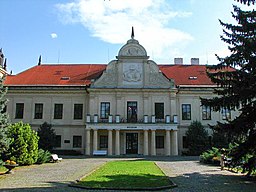Trebisov
| Trebišov | ||
| Town | ||
|
A museum in Trebišov
|
||
|
||
| Country | Slovakia | |
|---|---|---|
| Region | Košice | |
| District | Trebišov | |
| Elevation | 109 m (358 ft) | |
| Coordinates | 48°37′40″N 21°43′02″E / 48.62778°N 21.71722°ECoordinates: 48°37′40″N 21°43′02″E / 48.62778°N 21.71722°E | |
| Area | 70.160 km2 (27.09 sq mi) | |
| Population | 23,152 (2005-12-31) | |
| Density | 330/km2 (855/sq mi) | |
| First mentioned | 1254 | |
| Mayor | Marián Kolesár | |
| Timezone | CET (UTC+1) | |
| - summer (DST) | CEST (UTC+2) | |
| Postal code | 075 01 | |
| Area code | +421-56 | |
| Car plate | TV | |
| Statistics: MOŠ/MIS | ||
| Website: www.trebisov.sk | ||
Trebišov (Hungarian: Tőketerebes; German: Trebischau) is a small industrial town in the easternmost part of Slovakia, with a population of around 23,000. The town is an administrative, economic and cultural center with machine (Vagónka) and building materials industries.
The first archaeological findings are from the Neolithic. Tombs were found from the Otomani Culture of the early Bronze Age and the building structures from Hallstatt Culture from late Bronze Age.
The name of Trebišov is first mentioned in 1219 as Terebus, later in 1254 as Terebes, and in 1341 as Therebes, in 1441 the sources depict as Felse Terebes, Also Terebes (Upper and Lower Trebišov). The village is also mentioned in 1330, when it received town status for the first time. The castle and the village became one settlement in the 14th century.
The first written reference to the castle stems from 1254. This castle of Parič (Párics) stood at the border of the village. The village originally was established to serve the castle. The castle was built by "Terebesi" family from "Kaplyon" nobility. Károly Róbert has conquered the castle in 1317 during the fight with Petenye fia Péter and granted the land as gift to Fülöp Drugeth, the zupan of Spiš, but then returned to royal ownership in 1342, to the Zemplén county. After 1387 the castle was given by Sigismund of Luxemburg to Péter Perényi, who soon became a "robber knight". Mathias Corvinus has overtaken the castle in 1483 and given the castle to the son of the defeated knight. As the Ottomans were approaching in 1536, the castle was reinforced, and further in 1541. The Drugeth family took over the castle by marriage in 1567, but in 1619, Gábor Bethlen sieged and occupied it.
...
Wikipedia






